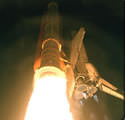
Image credit: NASA
Space shuttle managers are debating whether to end the space shuttle Columbia’s mission to upgrade the Hubble Space Telescope because one of its two cooling systems isn’t working properly. Although the shuttle is equipped with two redundant systems, NASA flight rules demand that the shuttle return to Earth if either completely fail – right now, one is just blocked and not working at full capacity. Mission controllers will make a decision to scrub the mission or keep going Friday evening.
Following Columbia?s on-time launch from the Kennedy Space Center this morning, flight controllers in Mission Control noticed a degraded flow rate in one of two freon cooling loops that help to dissipate heat from the orbiter.
There are two freon cooling loops that are part of the shuttle?s active thermal control system, one on the port and one on the starboard side of the payload bay. Freon loop 1 on the port side is showing a degraded flow rate.
While low, the flow rate is slightly above flight rule limits. Mission managers are currently reviewing the flight data and studying the past performance of the sensors that measure the flow rate of the freon through the loops to build confidence in the performance of the freon loop and its ability to support the STS-109 mission through completion.
After reaching orbit this morning, Commander Scott Altman and Pilot Duane Carey commanded the first in a series of engine firings to position Columbia for its Sunday morning rendezvous with the Hubble Space Telescope. Their crew mates ? Mission Specialists John Grunsfeld, Mike Massimino, Nancy Currie, Jim Newman and Rick Linnehan ? began readying Columbia for its on-orbit operations by stowing away their launch and entry suits and opening the interior hatch to Columbia?s airlock.
This is Columbia?s first flight since July 1999, following an extensive modification period in which many of its systems were replaced or enhanced. Columbia was NASA?s first shuttle orbiter and flew for the first time in April 1981.
The next status report will be issued following the crew?s scheduled wake-up call at 8:22 p.m., or as events warrant.
Original Source: NASA News Release
